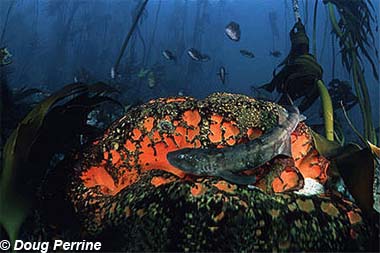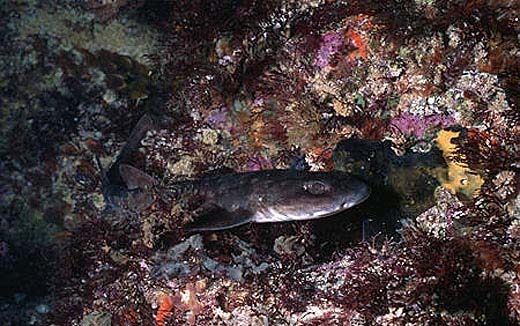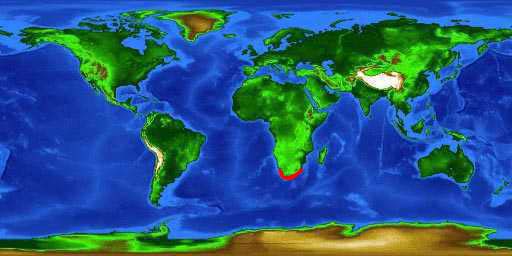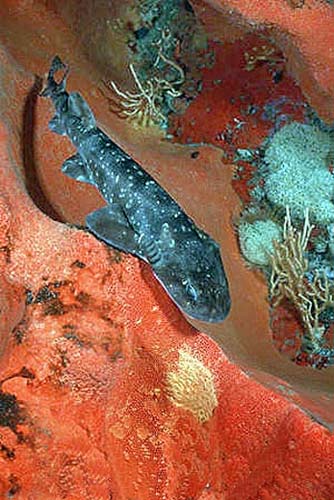Dark Shyshark

Haploblepharus pictus
This species of shark has an elongated torpedo-shaped body and rarely grows longer than 22 inches from blunt snout to stout caudal (tail) fin. It has an oval cat-like eye and is a yellowish-brown with dark saddles and dark and white spots. A sedentary shark, it prefers the shallow, sandy bottoms off the southern coast of Africa, where it can hunt crustaceans and cephalopods. Considered harmless to humans, when threatened, shy sharks will curl into a loop and hide their faces in their tails.
Order – Carcharhiniformes
Family – Scyliorhinidae
Genus – Haploblepharus
Species – pictus
Common Names
- English: dark shyshark, dark shy shark, and shyshark
- Afrikaans: donkere schaamhaai
- Czech: roussette somber, tmavý žralok stydlivý
- Dutch: mácka tmavá
- French: skaamhaai
- Spanish: donker skaamoog
Importance to Humans

Although not important commercially, this shark is captured in local subsistence fisheries. This species is often caught with rod and reel by recreational surf anglers. However, it is considered a little-utilized species due to its small size. It is probably discarded from bottom trawlers and by recreational fishers as bycatch due to its reputation as a minor pest species (Ellis. 2000).
Danger to Humans
The dark shyshark poses little threat to humans due to its small size and feeding habits (Compagno, et.al., 2005).
Conservation
The dark shyshark is listed as “least concern” with the World Conservation Union (IUCN). The IUCN is a global union of states, governmental agencies, and non-governmental organizations in a partnership that assesses the conservation status of species. This small catshark resides in a very limited range off the coast of southern Africa. This region is heavily fished and has potentially degraded inshore water quality. If fishing increases in inshore waters or habitat is further degraded, the population of this endemic species could be greatly impacted.
> Check the status of the dark shyshark at the IUCN website.
Geographical Distribution

This species resides in the waters of the southeast Atlantic Ocean from Namibia to southwestern Cape Province, South Africa (Ellis. 2000).
Habitat
This small demersal shark inhabits inshore waters of the continental shelf and is most commonly observed in shallow sandy-bottom habitats (Ellis. 2000).

Biology
Distinctive Features
Stout body and broad head, this species, as with all members of Scyliorhinidae, possess rudimentary nictitating lower eyelids. The anterior nasal flaps are subtriangular and do not overlap the mouth posteriorly. The gills slits are located dorsolaterally on each side of the body. The origin of the first dorsal fin is located in front of the pelvic fin insertions.
Coloration
Yellowish-brown with dark markings and a few larger lighter colored spots lacking black margins. There are seven dark brown to black dorsal saddles. The fins are yellowish-brown in color (Compagno, et.al., 2005).
Dentition
Ventral mouth, possessing several rows of multi-cuspid teeth (Ellis. 2000).
Size, Age, and Growth
The maximum reported length is 57cm (22.4 in.) total length (TL) (Compagno. 2005).
Food Habits
Feed on small bottom-dwelling fish, crustaceans, and cephalopods (Ellis. 2000).
Reproduction
Oviparous with one egg released per oviduct. The egg cases are 2.4 inches (6cm) in length and 1.2 inches (3cm) wide. In captivity, one egg case hatched in approximately 3.5 months (Vas. 1995).
Predators
Potential predators include large fish including sharks as well as marine mammals (Compagno, et. al., 2005).
Parasites
A parasite found in the blood of the dark shyshark (and its close relative the puffadder shyshark) is the trypanosome Trypanosoma haploblephari. It is the first species of trypanosome described from sharks residing in South African waters (Yield et al., 2006).
Taxonomy
Müller & Henle originally described the dark shyshark as Scyllium pictum in 1838. This name was later changed to the currently valid scientific name of Haploblepharus pictus Müller & Henle 1838. Johannes Peter Müller (1801-1858) was a German physiologist and comparative anatomist with a keen interest in fishes and marine invertebrates. Friedrich G. J. Henle (1807-1885) was also a German physiologist as well as a pathologist and histologist.
The genus name Haploblepharus is derived from the Greek “haploos” meaning single and “blepharos” meaning eyelash. Scyliorhinidae is the largest shark family with at least 15 genera and over 110 species. They are known as catsharks due to their elongated cat-like eyes, although a few species are referred to as dogfish.
Revised by: Kiersten Meigs 2020
Prepared by: Cathleen Bester
References:
- Compagno, L. (2005). A Field Guide to the Sharks of the World. Harper Collins.
- Ellis, J. (2000). Sharks, Skates, and Rays: the Biology of Elasmobranch Fishes. Journal of Experimental Marine Biology and Ecology, 246(1), pp.139-141.
- Vas, P. (1995). The reproduction and development of sharks, skates, rays and ratfishes. Journal of Experimental Marine Biology and Ecology, 186(1), pp.135-136.
- Yeld, E. and Smit, N. (2006). A new species of Trypanosoma (Kinetoplastida: Trypanosomatidae) infecting catsharks from South Africa. Journal of the Marine Biological Association of the UK, 86(04), p.829. (Yield et al. 2006)